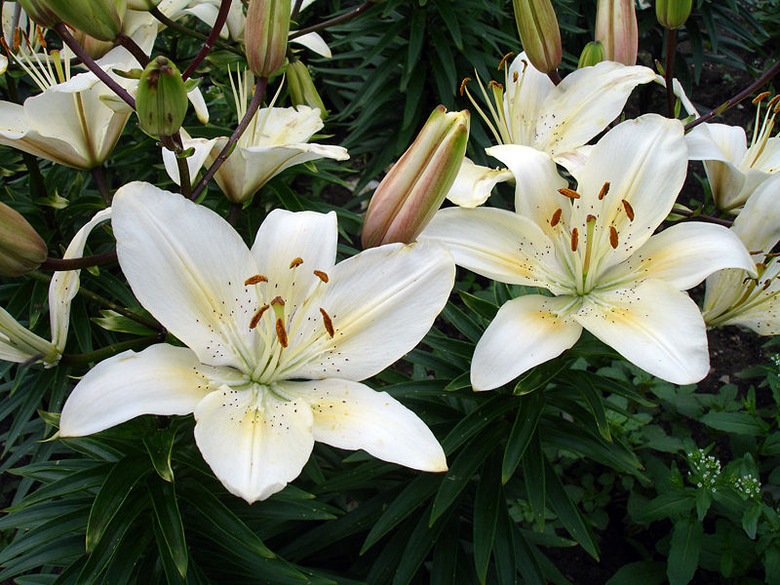How To Transplant Asiatic Lilies
Asiatic lilies are summer-blooming plants that grow from bulbs. They are desirable for their profuse and long-lasting blooms on tall, strong stems. Hardy in USDA zones 3 through10, they are grown in beds, borders, containers and cutting gardens. Lilies purchased from a garden center in nursery pots can be planted in the garden anytime of the year in climates where they are hardy. Naked bulbs are best planted in the spring or fall.
Step 1
Prepare a planting bed for your lilies by tilling up a nutrient-rich soil so it is loosened and easy to work with. Asiatic lilies adapt well to most soils, save very heavy clay. If your soil is nutrient-poor, amend the planting site with several pounds of compost or well-aged manure, tilling it in well.
- Asiatic lilies are summer-blooming plants that grow from bulbs.
- Asiatic lilies adapt well to most soils, save very heavy clay.
Step 2
Place your mature Asiatic lily plant in the soil, in a hole at least twice the diameter of the root ball and at least as deep as the root ball. Slip the plant out of its nursery pot, and place the intact root ball into the prepared hole, maintaining the same soil level on the plant stem. Back-fill soil around the root ball to stabilize it, and tamp down to collapse any air pockets.
Step 3
If you're planting bulbs, bury them in the prepared soil at a depth of 4 to 5 inches. Plant sloping side up and root plate down, and gently pack soil around the bulb to set it. Plant multiple bulbs at intervals of 4 to 6 inches.
Step 4
Water in the transplanted lily plants or bulbs well, and lay down a 1-inch blanket of organic mulch, like shredded bark or cocoa hulls, to preserve soil moisture and keep weeds down.
- Place your mature Asiatic lily plant in the soil, in a hole at least twice the diameter of the root ball and at least as deep as the root ball.
- Water in the transplanted lily plants or bulbs well, and lay down a 1-inch blanket of organic mulch, like shredded bark or cocoa hulls, to preserve soil moisture and keep weeds down.
Transplant Ginger Lilies
Clear away any grass, weeds and debris from a new planting area, and make sure it's located in full or partial sun. If planted in the shade, the lilies will lean toward the light. Spread a couple of inches of compost over the planting area and dig it into the top 8 inches of soil with a shovel. Rake the soil surface until it's level. Shake enough dirt off the root ball so that the individual rhizomes are visible. Make sure each piece possesses an actively growing shoot. Space the rest of the ginger lily rhizomes 24 to 36 inches apart.
- Clear away any grass, weeds and debris from a new planting area, and make sure it's located in full or partial sun.
- Shake enough dirt off the root ball so that the individual rhizomes are visible.
Things Needed
- Compost or aged manure
- Asiatic lily plants or bulbs
- Bulb fertilizer
- Water
- Mulch
References
- Iowa State University
- University of Minnesota
- Plants for a Future: Hedychium Coronarium
- Plant of the Week: Hedychium Coronarium –- White Ginger
- Floridata: Hedychium Coronarium
- University of Florida IFAS Extension: Hedychium Coronarium Butterfly Ginger
- Georgia Perennial Plant Association: Ginger Lilies — Hedychium Coronarium
